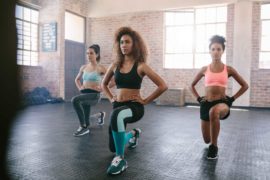If you are here today it is because you are determined to train at home. I want to congratulate you on making that decision. You will achieve results. You must have good planning for your training. Also, you accompany it with a good diet and a good rest for muscle recovery.
Now, if you pay attention, because of the scientific evidence I will explain each of the fundamental variables. This way, you are able to program your training.
Variables of Home Workout Routine
Intensity or the degree of effort you perceive from each series. Regardless of the load used or repetitions made, there is a recruitment of the entire spectrum of motor units. The fatigue of a mechanical stimulus produces, which is necessary for the production of hypertrophy.
You will have to train at or near failure to promote the growth of your muscle mass. This becomes more important when we train at home where we limit in weight and equipment. Muscle failure in resistance exercise is the main point during exercise performance. It is when this neuromuscular system no longer produces adequate force for overcoming a specific workload.
Simply stated! It is when the muscle, in a series, is unable to produce enough force. The purpose is to overcome the resistance exerted by any load. Unable to perform more repetitions, for example.
However, working to failure is not optimal compared to training near it. The fatigue ratio is in favor of the latter. So, the accumulated fatigue is greater than the stimulus itself that is taking the muscle. On the other hand, by training near failure, we can control fatigue by keeping the stimulus in favor of or in the same way. Therefore, the stimulus is optimal.
Home Workout Routine – REPS

Most of your sets are in a repetition range of 6 to 20 in most exercises such as squats, push-ups, bottoms, pull-ups, etc. In short, compound exercises. Because performing more than 15 repetitions in a series is very tiring and the stimulus is less.
It is important to mastering basic exercises with bodyweight or low weight. It is usually common when training at home, it is easy to exceed 25 repetitions. We want to achieve repetitions of 7 to 9, especially in leg exercises.
Choosing exercises that are more difficult for you to achieve a higher repetition, it is important not to exceed 25 reps.
Number of sets per muscle group per week
As this article focuses on body composition, we will understand the Training Volume. It is the amount of work done over a period of time. So, it is the number of effective sets for a muscle group per week.
There is sufficient evidence to show that the higher the volume. So, the greater the hypertrophy, regardless of the repetitions, provide the series are effective in nature. But watch out. More is not better, much less.
The minimum and a maximum threshold of work that is able to tolerate vary depending on the level of training. So, the first step is to identify your level of experience. This has nothing to do with the time you have been attending a gym or training. It is because you can take years exercising and still have not yet gone from a beginner.
Step 1: Identify your training level
| level | Volume |
| Beginner. Able to progress in weights or repetitions every week or session. | 10 to 12 series a week. |
| Intermediate. He has trained intelligently and consistently for more than 6 months or just under a year. Unable to progress session by session. | 12 to 16 series a week. |
| Advanced. He has trained intelligently and continuously for over 2 years and is very close to his full genetic potential. | 14 to 25 weekly. |
When it comes to Home Workout Routine, question yourself, and recognize what level you are at to plan your training. Identifying yourself as a beginner shouldn’t embarrass you even if you’ve been training for years.
In fact, being a beginner you can progress each training session (as long as you have good planning). This no longer happens when you are intermediate, much less when you are advanced.
Not because you cannot progress from one session to another, you should assume that you are intermediate. It is because you may not have a training program adapted to you. Or that you are failing in one of the other two pillars such as food and rest.
It is important to emphasize that according to your level of experience. There is a work capacity that we are able to tolerate. If you exceed, you will not achieve greater results compared to training with the volume that corresponds to your level.
Step 2: Quantify the Training Volume
Well, we already know what our training volume is. Now we must learn to quantify, recognizing the muscles that work the exercises we do. We will touch on this point further below.
PRACTICAL EXAMPLE
A beginner has to get 12 sets of quads a week. For this, the beginner decides to do 12 sets of squats a week. The quadriceps is the main muscle that participates in this exercise. Therefore, these series (the 12 if each one is carried out effectively) are equivalent to the volume of work for this muscle.
The same would happen if you had to do 10 sets of chest a week. Simply choose exercises in which this muscle is the main or sole responsible for performing the exercise. These include push-ups, parallel bottoms, chest openings with resistance bands, etc.
Train each muscle group per week

Training frequency is the variable in charge of distributing your training volume throughout the week. You can achieve it through the number of times per week you spend training a certain muscle group.
The more days of the week you have to distribute this volume, the greater the muscle gains. It is due to the little stress generated in the sessions and the better recovery that this entails. The fewer times per week you want, the more limited the muscle gains you are looking for.
| Volume | Frequency |
| Less than 10 weekly series | F1 |
| 10 to 15 weekly sets | F1 or 2 |
| 15 to 20 weekly series | F2 |
| 20 to 25 weekly series | F2 or 3 |
| More than 25 weekly series | F3 or more |
Selection of Exercises
When selecting the exercises, the most important thing is to know which muscles involve in order to count the series.
| Exercises and Muscle Groups that Work | ||
| Movement Pattern | Primary Muscle | Secondary Muscle Groups |
| Squat (all its variants) | Quadriceps and Buttocks | Spinal Erectors |
| Hip Hinge (Deadlift and Variants, Morning, Back Extension) | Buttocks, Hamstrings | Back |
| Hip Extension (Hip Thrust, Glute bridge, and variants of each) | Buttocks | Hamstrings |
| Vertical Drive (Dominated and variants) | Back (Dorsal) | Biceps and Delt.Posterior |
| Horizontal Pulls (Oars, Face Pull and variants of each) | Back (Trapezius) | Biceps, Deltoids, Posterior and Medial. |
| Horizontal Push (bench press, push-ups, bottoms and variants of each) | Chest | Triceps, Anterior and Medial Deltoids. |
| Vertical Push (Military Press, Pine Push- ups and variants of each) | Delt. Anterior and Triceps | Medial and Back (Trapezius) |
| Pull Over (and variants) | Back (Dorsal) | Triceps and Chest |
| Chest Openings (and variants) | Chest | Delt. Previous |
| Isolation Exercises | Target Muscle | No |
PRACTICAL EXAMPLE
You decide to do 3 sets of Bulgarian dumbbell squats. In total, you would be adding to your training volume 3 series for quadriceps. One and a half series or 1.5 series for spinal erectors. Assuming that the series is effective.
Recommended training material
Talking about Home Workout Routine, I will teach you which are the best training materials. This is according to the variety of exercises you can do. Also, it is about the intensity you can add to other basic exercises.
| Training material | Function |
| Water Bottles, Dumbbells and Backpack | It allows you to add more intensity through the weight you decide to lift. On the other hand, you also have a wide variety of exercises that you would do in a gym. This is especially isolation exercises such as a bicep curl or lateral shoulder lift and others. Just use these materials just as you would a dumbbell in the gym. |
| Resistance Bands | Manipulating the intensity of the exercise is easy. It is because we can choose between the different bands you have according to the resistance they offer. In addition, of course, you can also do a lot of exercises. |
| TRX | It is convenient for the great variety of exercises that we can do. This is especially for the upper body. |
| Chin-up Bar | It is useful because it offers a wide variety of important exercises such as chin-ups and abdominal exercises such as hanging legs. |
| Abdominal Wheel | One of the best abdominal exercises we can do requires this material. |
How to warm up before exercising at home?

Warming up before any workout is essential. And 5 to 10 minutes of low-effort cardio can help us warm up before starting the workout routine at home.
Examples of Warm-up
- You can jump rope, even if you don’t have a rope you can pretend you are holding it in your hands and spinning it.
- You can also do an elliptical if you have one at home.
- Static jogging.
- Or up and downstairs if you live in a building.
But just a little cardio is enough, you will have to complement it with some approach series. That is, from 2 to 4 sets at 8-15 reps of your first exercise with 30-70% of the maximum weight. It is that you plan to use in it for the effective sets.
We will know if the warm-up has been effective if the following adaptations are met:
- With the warm-up, we seek to achieve higher body temperature.
- Accelerate the heart and respiratory rate.
- Lubricate our joints.
- Practice movement.
- Obtain adaptations of the central nervous system so that it transmits the transmission of the nervous impulse in an optimal way.
It is important to dedicate the necessary time to the warm-up to achieve greater performance. Also, it is about more effective training, less risk of injury, and less central fatigue. Likewise, it is about better post-training rest, which means better recovery and later performance.
Week 1 of Home Workout Routine
Every week you can increase the weight you use or the repetitions. However, you can meet the proposed repetition range, repetitions, and without harming the technique.
| Monday to Saturday | |||||
| Exercise | Series | Reps | Weight | RPE | Rest between sets |
| Choose 1 of the 2 options : | |||||
| Option 1: Knee Push-ups | 4 | 8 to 30 | 9.5 | 1-3min | |
| Option 2: Wall Flexion | 4 | 8 to 30 | 8.5 | 1-3min | |
| Horizontal Dominated between 2 Chairs | 3 | 5 to 20 | 8 | 1-3min | |
| Hip Thrust | 3 | 5 to 30 | 8 | 1-3min | |
| Choose 1 of the 2 options : | |||||
| Option 1. Support Squats | 4 | 10 to 30 | 9 | 1min | |
| Option 2. Squats | 4 | 10 to 30 | 9 | 1min | |
| Abdominal iron | 2 | 5s to 1min | 8 | 1-2min |
Week 2 of Home Workout Routine
The first thing, for this second week, is to seek to perform more reps than the previous week while maintaining the same number of series. If you are already at the limit of the recommended rep range then:
It seeks to increase the range of motion, reduce the tempo in the eccentric phase. It can reduce breaks between sets to achieve increased intensity. If there are any exercises that you can’t progress on then go to the previous week’s version and simply try to increase repetitions.
In the squat exercise, try to add weight with a bag or backpack on your back. Seek to add 2.5 to 5 kilos each week, as long as you’ve mastered bodyweight squats and can’t add more reps without exceeding the recommended range.
| Monday to Saturday | |||||
| Exercise | Series | Reps | Weight | RPE | Rest between sets |
| Tilt Rows | 3 | 5 to 20 | 8 | 1-3min | |
| Choose 1 of the 2 options : | |||||
| Option 1.- Knee Push-ups (Easier) | 3 | 3 to 30 | 9.5 | 1-3min | |
| Option 2.- Push-ups on the floor (more difficult) | 3 | 3 to 30 | 9.5 | 1-3min | |
| Bank Funds | 4 | 3 to 30 | 8.5 | 1-3min | |
| Buttock Bridge with Raised Feet | 3 | 5 to 30 | 8 | 1-3min | |
| Choose 1 of the 2 options : | |||||
| Option 1.- Squats | 4 | 10 to 30 | 9 | 1min | |
| Option 2.-Weighted squats | 4 | 10 to 30 | 9 | 1min | |
| Side Plank | 2 | 5 to 20 | 8 | 30-60s | |
| Inverted Abdominal Crunch | 3 | 5 to 30 | 8.5 | 1-2min |
Week 3 of Home Workout Routine
For this third week we seek to continue increasing in reps as long as the recommended range allows us. If you are already at the top of the range that we have recommended, then you should seek to increase the intensity with one of the following strategies.
Increase range of motion. Taking a much more complete tour allows the muscle to get better stimulation.
Put weight on. If exercise allows you can add weight with a backpack or resistance bands. For example, for push-ups on the floor, you can put on a backpack and put more weight into it every session.
Slow down the exercise. Especially in the eccentric phase.
Reduce rest times. If you have already played the previous cards then you can reduce the rest times to increase the intensity of the training.
Remember that the key to effective home training is intensity. Work with series very close to muscle failure.
| Exercise | Series | Reps | Weight | RPE | Rest between sets |
| Straight leg bridge | 2 | 3 to 20 | 8 | 1-3min | |
| Horizontal Dominated between 2 Chairs | 3 | 5 to 20 | 8.5 | 1-3min | |
| Choose 1 of the 2 options : | |||||
| Option 1.- Knee Push-ups (Easier) | 4 | 8 to 30 | 9.5 | 1-3min | |
| Option 2.- Push-ups on the floor (more difficult) | 4 | 8 to 30 | 8.5 | 1-3min | |
| Choose 1 of the 2 options : | |||||
| Option 1.- Squats | 4 | 10 to 30 | 9 | 1min | |
| Option 2.-Weighted squats | 4 | 10 to 30 | 9 | 1min | |
| Triceps extension on lower surface | 2 | 3 to 20 | 9.5 | 1-2min | |
| Cross-body Mountain Climbers | 2 | 8 to 25 | 8 | 1-2min |
Week 4 of Home Workout Routine
For this week we are still looking for some progressions to increase the difficulty and intensity for some exercises. If you cannot progress in any of them, go back to the previous week and try to do more repetition.
You stay within the recommended range at the indicated intensity or incorporate weight with some of the recommended materials. If you easily exceed the rep range then it will be time to look for a progression.
Add weight, decrease rest time, increase range of motion, or apply some other strategy to ensure progressive overload.
| Exercise | Series | Reps | Weight | RPE | Rest between sets |
| Lean Rows with backpack weight) | 3 | 5 to 20 | 8.5 | 1min-3min | |
| Option 1.- Push-ups on the floor (Easier) | 4 | 8 to 30 | 8.5 | 1min-3min | |
| Option 2.- Decline push-ups (more difficult) | 4 | 8 to 30 | 8 | 1min-3min | |
| Bank Funds | 4 | 3 to 30 | 8.5 | 1min to 3min | |
| Buttock Bridge with Raised Feet | 3 | 5 to 30 | 8.5 | 1min to 3min | |
| Weighted squats | 4 | 10 to 30 | 9 | 1min | |
| Side Plank | 2 | 5 to 20 | 8 | 1: 30min | |
| Inverted Abdominal Crunch | 3 | 5 to 30 | 8.5 | 1min-2min |
Conclusion
No matter the weight you lift, as long as there is a high degree of effort the stimulus will be the same. Place most of your sets in a range of 6 to 20 reps.
Recognize what level you are at to apply the amount of work that corresponds to you. Divide this entire training volume into a Frequency 2 or 3.
Count the training volume of each muscle group depending on the exercises you do. Choose the training material needed to achieve a high RPE of 7-9 that falls within the proposed number of repetitions (6 to 20).
Strive in all your workouts in order to offer your body a new stimulus in order to achieve adaptations.







